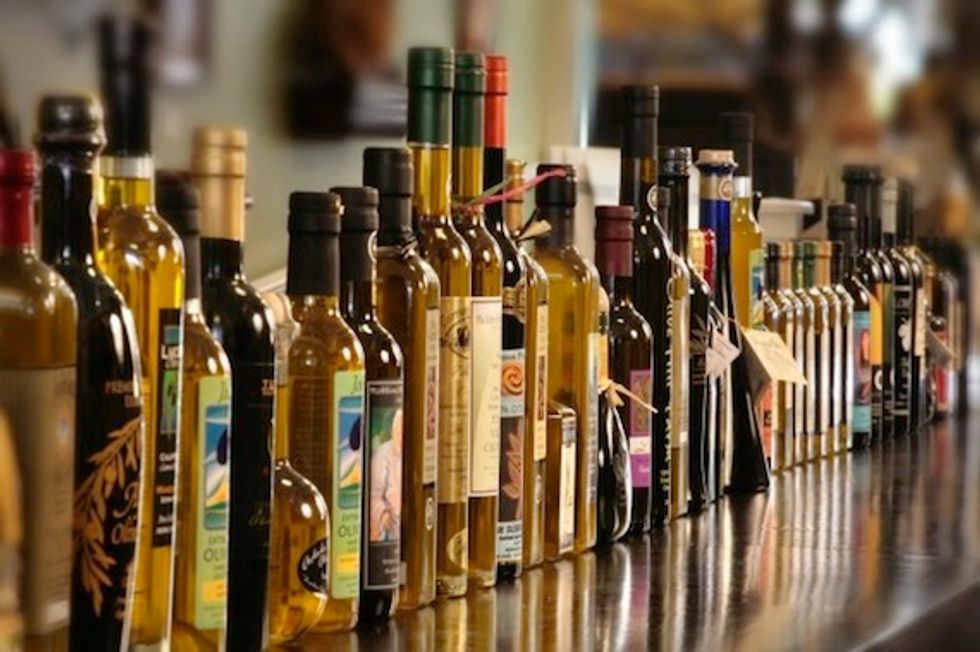Consumers unwittingly collect olive oil as they would wine, decorating their counters with lean, dark bottles emblazoned in elegant labels to be used sparingly over the next year or more. However, reports of an influx of counterfeit extra virgin olive oil from overseas have buoyed local producers' efforts to show shoppers their California product is not only pure, but fresher and tastier.
Becoming an extra virgin olive oil, the A+ of olive oils, requires certification from the California Olive Oil Council (COOC) or International Olive Oil Council (IOOC). Both organizations have slightly different though comparably rigorous criteria to test the oil to ensure it has no defects, low acidity, and was produced without chemicals under first cold press. ("First press" means the olives were pressed once while “cold” refers to the temperature of the olives during extraction.)
“People should think of olive oil as a perishable product like cheese or dairy,” says Maia Hirschbein, a California olive oil consultant who earned a master's in Food Culture and Communications from the University of Gastronomic Sciences in Italy. “It’s something you have to buy frequently.
Here are five more tips to improve your EVOO IQ:
1. Filtered versus unfiltered
“Filtration is controversial,” says Hirschbein. It’s the process of straining the oil to remove any large olive bits. “People who filter say it doesn't affect aroma, and people who don’t filter say it does.” Unfiltered olive oil is more expensive, spoils more quickly, and may appear cloudy due to the suspension of olive particulates. “It has more olive kick,” says Ryan Jones, a member of the Sciabica family, the oldest olive oil company in California, which produces both filtered and unfiltered varieties. When deciding what type to cook with, many people opt for a filtered or less expensive extra virgin olive oil.
“If you have a really delicate, fruity oil, and you saute in it, that aroma is going to be the first thing that burns off.” says Hirschbein, who admits that she uses less expensive bottles for cooking. On its website, the COOC explains that olive oil has a lower smoke point than seed oils (i.e canola or soybean) but a higher one than butter.
Olive oils, however, can have varying smoke points, according to Hirschbein, who explains that higher quality and refined extra virgin olive oils have higher smoke points than low quality ones. Whatever caliber of oil you decide to cook with, follow Jones’s recommendation of pouring the olive oil into a cool pan before turning on the heat. Pouring it into a hot pan will cause it to smoke.
Photo from We Olive's Facebook
2. Stay in the dark
Oil spoils from oxidation, exposure to light or heat, and time. Look for dark bottles, and keep them away from windows or heat sources like the oven. At Sciabica’s, they use clear bottles that are UV-proof.
3. Find your flavor
The oil’s flavor is determined by time of harvest and olive variety. “An early-harvest olive oil, which is produced in October entirely from green olives, is going to be grassier and more intense more robust in flavor,” says Sebastian Bariani of Bariani Olive Oil. Early harvest olive oils appear green. Oils produced late in the season, which runs until about mid-December, are made from ripe black olives which have a correspondingly fruitier, milder and sweeter taste.
According to Hirschbein, the best time to buy olive oil is in January, when the season’s fresh batch has just gone to shelves. Any time you buy, check the harvest date, which should be printed on the bottle. If there’s no harvest date, suspect that the oil may be more than a few years old. An unopened bottle will keep one to two years, according to Hirschbein. Once opened, she recommends consuming it within four months.
4. High price equals high quality?
Generally, yes. “Price is an indication of quality and size of producer,” says Hirschbein. Smaller producers charge higher prices to offset exorbitant production costs. Many companies harvest completely by-hand, though some are experimenting with more modern methods of production called Super High Density, in which they plant trees closer together and employ machine harvesters.
5. Taste like a pro
Just like beer, wine or chocolate, olive oil has its own tasting ritual. First, gently warm the oil to release its aromas by pouring a little directly into the palm of your hand, Hirschbein’s preferred method, or into a cup and then covering and swirling gently. When professional tasters analyze oil, they use a special, dark blue cup to obscure the appearance so that they won’t be influenced by color. Next, inhale. As with wine, you’re encouraged to call out any grassy, fruity, or other odors. Then slurp. Slurping helps the the oil to slide around your tongue and touch every taste bud. There’s no spitting here. You must swallow to feel the pungency in the back of your throat.
When shopping for olive oils, go somewhere where you can sample, advises Hirschbein. We Olive in the Marina, Olive This Olive That in Noe Valley, and both McEvoy Ranch and Stonehouse Olive Oil Company in the Ferry Building allow customers to taste the gamut. Farmers markets are another great venue to meet the producers experience their “liquid gold.”






















